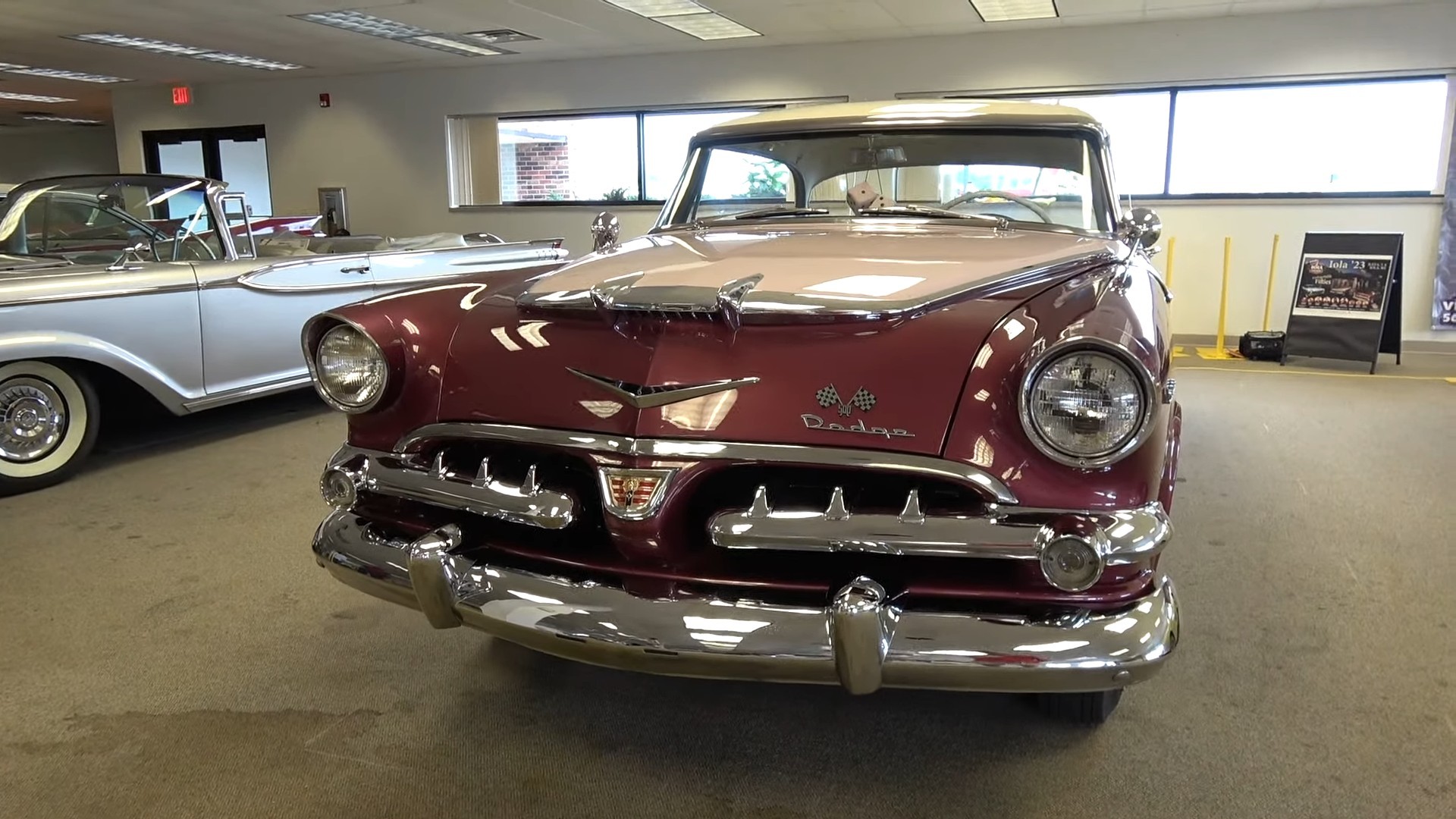The nifty fifties were some of the most extraordinary years for Chrysler Corporation, resulting in the release of some of the most spectacular automobiles ever to come from Highland Park. Virgil Exner’s Forward Look design philosophy was backed by serious motoring achievements, hard-earned on the race ovals, drag strips, and plain roads.
In 1955, Dodge’s lineup consisted of the base Coronet, the level-up Royal, and the range-topping Custom Royal. This is where things get somewhat confusing, as the cars came in two- and four-door configurations (hardtop or sedan) and two-door soft-top.
In the excellent tradition of the mid-50s fashion of overcomplicating all possible aspects of life, the hardtops were distinguished by yet another name: the Lancer. Hence, the phrase “1956 Dodge Custom Royal Lancer” described a two- or four-door hardtop or a convertible. Catchy nameplate – royalty-style – but there is more to this memory-testing nomenclature.
There was also a particular version of the Dodge: the D-500, a performance option that meant appealing firepower. Suffice it to say that a stock example (a four-door hardtop randomly chosen off the assembly line and swiftly dispatched to the Bonneville salt flats in Utah) set 306 speed and endurance records over the course of fourteen tormenting days.

Chrysler claimed the 1956 Dodge D-500 was the world’s fastest production car for that year, and NASCAR proved them right, with the high-performance model winning 11 races of that season. At the time, NASCAR was all about “Win on Sunday, sell on Monday” – the cars were mandated to be in the factory version sold to the public. Even the spare tire and jack were in the trunks of the National Association for Stock Car Auto Racing racecars.
Behind this remarkable success of Dodge stood Chrysler’s wartime research and development effort’s secret weapon. A mechanical innovation so magnificent it became the Mopar staple of ultimate performance: the HEMI engine – although in the 50s, the battering ram word hadn’t yet been coined.
The first generation of the famous dome-shaped combustion chambers was christened FirePower and was used by Chrysler models. The corporate nomenclature reserved the “Super-Powered Super Red Ram” call sign for Dodge. In 1956, that engine was a 315 cubic-inch (5.2-liter) performance V8.
Backed by a four-barrel carburetor, the powerplant would churn out 260 hp (264 PS) and 330 lb-ft (447 Nm). The standard transmission was the three-speed manual, with the optional Magic Touch pushbutton two-speed automatic.

Incidentally, this is the drivetrain setup of this example in the video – a well-preserved, well-maintained 1956 Dodge Custom Royal Lancer D-500 (Chrysler’s execs probably loved mnemonics). Featured at the Iola, Wisconsin car show, the automobile (mostly original, except the paint – which has been refreshed 30 years ago) is the highest-performing street variant Dodge had to offer for 1956. (Please note: the NASCAR version – dubbed D-500-1 – used two four-barrel carbs, not one, for an extra 25 hp).
The car has a heart-melting story: initially owned by a good friend of its current proprietor, this automobile became a lifetime-friendship recognition gift. The widow of the previous possessor didn’t sell the Dodge but made it a present for her late husband’s best friend, Mr. Frank Cirino.Automotive media – and official records – praised the double-checkered-flag-badged Dodge, and not undeservingly.
But the combination of a HEMI (let’s call it that, for Mopar’s sake), quick-fading drum brakes, floaty suspension, and less-than-pinpoint-accurate power steering would have made a white-knuckle experience when going flat out.
Apart from the go-fast attribute, the Dodge had other attractions for the occupants. For the record, radio was the epitome of in-car entertainment in the period, but Dodge had an ace up its dash: the Highway HiFi, a Chrysler-patented sound system. It played specially developed records that could offer two full hours of music when the radio reception wasn’t available.

About the radio: in the 50s, America was waging its cold war against the Soviet Union, and an emergency radio broadcasting system was developed to maintain communication between authorities and the citizens. Called CONELRAD (short for Control of Electromagnetic Radiation), it used the AM band’s 640 or 1240 kHz frequencies. The car radio receivers would aptly mark the emergency tune-ins on the dials.
Despite its amenities (which were repellently expensive, to be fair), the model was short-lived, and it was archived at the end of the 1959 production year. However, it was one of the first cars to offer the tri-color exterior to the American public (Studebaker introduced the three-shade livery in 1955).
But critically, it was one of the earliest factory-built performance cars, a precursor to what would come to be known as muscle cars in the following decade. Although the blue-blooded-named Dodge Custom Royal Lancer D-500 didn’t set a trend in car baptizing, it introduced the notion of high performance as a sales incentive.
One last thing that must be said about the D-500 option: although the Super-Powered Super Red Ram was Dodge’s best-performing engine, some gearheads voiced their preference for the dual four-barrel setup. The reason is in-your-face obvious: more power.
Chrysler had already proven the hemispherical architecture’s capabilities. The one-horsepower-per-cubic-inch barrier fell under the pounding of the 355 CID (5.4-liter) FirePower of 1956 that produced 355 hp (360 PS). Dodge customers wanted a similar experience, and the 315-equipped cars could have achieved higher performance with two Carter carburetors and the three-speed manual transmission. This is precisely what Dodge did for the following model year, but that’s a different story.
